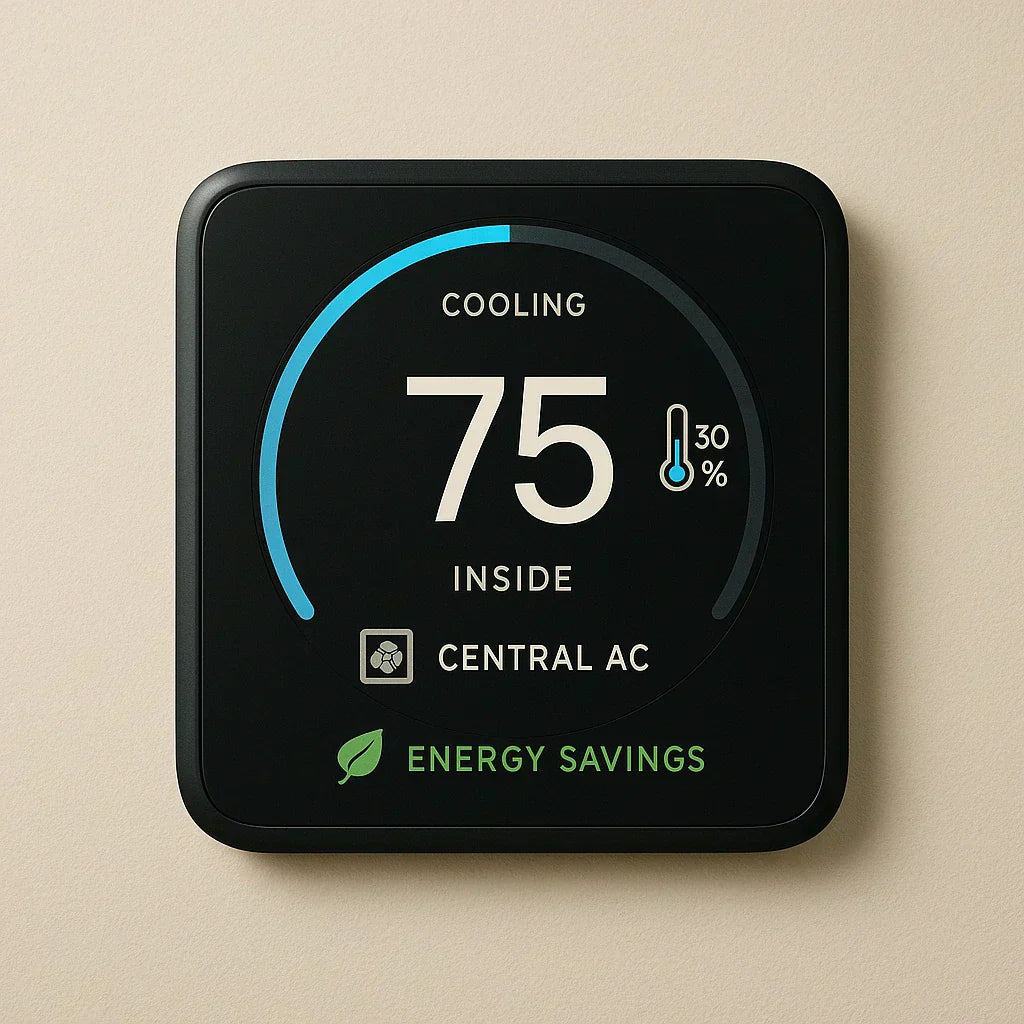When it comes to cooling comfort, your central AC’s efficiency isn’t just about the unit itself—it’s also about the thermostat controlling it. In fact, the right thermostat can improve system performance, lower energy bills, and extend equipment life by keeping cycles balanced and avoiding unnecessary strain.
In this guide, we’ll break down the best thermostats for central AC in 2025, the must-have features for efficiency, and how to ensure your thermostat is fully compatible with your cooling system.
For a full breakdown of top AC systems this year, check out the Top 10 Central AC Units Compared.
Why the Right Thermostat Matters for Central AC Performance
Your thermostat is essentially the “brain” of your HVAC system. Choose the wrong one, and you might lose out on key efficiency gains—even if your AC has a high SEER2 rating.
The thermostat controls how often your unit runs, how long each cycle lasts, and whether it’s fine-tuning temperature or overworking to compensate for poor calibration. A good thermostat can:
-
Optimize SEER2-rated efficiency by preventing short cycling
-
Maintain steady humidity control in hot, muggy climates
-
Learn your schedule to avoid wasted cooling
-
Integrate with other smart home systems for seamless comfort
📘 ENERGY STAR notes that certified smart thermostats can save homeowners around 8% on annual heating and cooling bills by automatically adjusting settings based on usage patterns.
Top Features to Look for in a Central AC Thermostat (2025 Edition)
SEER2 Compatibility and Staging Support
Modern AC units often come in single-stage, two-stage, or variable-speed designs. Your thermostat must match that capability to unlock maximum efficiency.
📘 Lennox explains that variable-speed systems can run longer at lower speeds for quieter operation and more precise temperature control—but only if your thermostat supports it.
Smart Scheduling and Learning Algorithms
Thermostats with adaptive learning can detect occupancy patterns and adjust cooling schedules without you lifting a finger.
📘 The U.S. Department of Energy reports that connected thermostats can automatically optimize cooling cycles to balance comfort with energy savings.
Humidity and Air Quality Control
Some thermostats integrate directly with whole-home dehumidifiers, ERVs, and advanced filtration systems, helping keep your indoor air healthy and comfortable year-round.
📘 The EPA highlights that maintaining proper indoor humidity levels not only improves comfort but can also reduce the growth of mold and dust mites.
App Control and Voice Assistant Integration
Remote control from a smartphone or voice assistant (Alexa, Google Home, Apple HomeKit) means you can adjust your AC from anywhere—perfect for avoiding wasted energy when you’re away.
Best Thermostats for Central AC in 2025
Here’s our pick of the best thermostats, categorized by need:
Best Overall – Ecobee Smart Thermostat Premium
-
Why it stands out: Built-in air quality monitor, advanced humidity control, and compatibility with variable-speed AC systems.
-
Best for: Homeowners looking for a single device to handle temperature, air quality, and smart home integration.
Best for Variable-Speed AC – Carrier Infinity Touch Control
-
Why it stands out: Seamlessly integrates with Carrier’s Infinity series for precise staging control.
-
Best for: Homeowners with high-efficiency SEER2-rated Carrier systems.
Best Budget-Friendly – Honeywell Home T9
-
Why it stands out: Affordable yet supports room sensors for even temperature distribution.
-
Best for: Smaller homes or those without zoning.
Best for Smart Homes – Google Nest Learning Thermostat
-
Why it stands out: Learns your schedule and adjusts automatically.
-
Best for: Homeowners already using Google smart home devices.
Best for Zoned Systems – Emerson Sensi Touch
-
Why it stands out: Flexible zoning controls with energy reports.
-
Best for: Multi-zone central AC setups.
📘 Consumer Reports ranks these models highly for ease of use, energy savings, and compatibility with modern AC systems.
Installation and Setup Tips
-
Match capabilities: Always verify that your thermostat supports your AC’s staging and SEER2 rating.
-
Professional calibration: A pro can ensure humidity controls and zoning features are set up correctly.
-
Keep firmware updated: Manufacturers often release updates that improve efficiency, add features, or fix bugs.
📘 According to Carrier, ensuring your thermostat and AC meet current efficiency standards is critical to maintaining compliance and maximizing performance.
Final Thoughts from Alex
If you’ve invested in a high-performance central AC, pairing it with the right thermostat is like putting premium tires on a sports car—it’s how you actually enjoy all that performance potential.
Don’t just shop for a “smart thermostat.” Look for one that matches your AC’s capabilities, supports humidity control, and integrates seamlessly with your lifestyle. It’s a relatively small upgrade that can pay back in comfort, energy savings, and fewer maintenance headaches down the road.
Next up: When to Replace vs. Repair Your Central AC Unit — learn how to decide when your cooling system has reached the end of the road.
Alex Lane
Your Home Comfort Advocate







